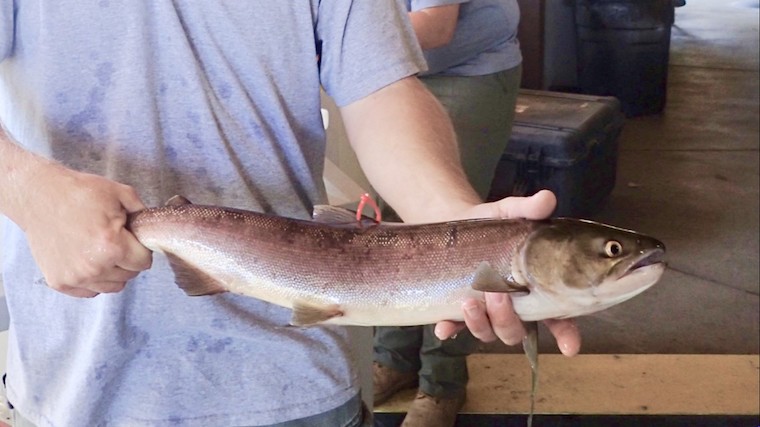forum
library
tutorial
contact

F&G Reports Faltering
Sockeye Run in 2021
by Emily Jones
Idaho Mountain Express, September 29, 2021
|
the film forum library tutorial contact |

|
F&G Reports Faltering
by Emily Jones
|
Salmon return 'challenging but not unprecedented,' department says
 Fewer than four dozen wild sockeye salmon naturally returned to spawn in the Sawtooth Basin this year due to poor ocean conditions, "potentially lethal" river temperatures and drought, the Idaho Department of Fish and Game reported on Friday.
Fewer than four dozen wild sockeye salmon naturally returned to spawn in the Sawtooth Basin this year due to poor ocean conditions, "potentially lethal" river temperatures and drought, the Idaho Department of Fish and Game reported on Friday.
About 115 sockeye made the arduous 900-mile journey from the Pacific Ocean to Redfish Lake in 2020. This year’s salmon run faced "numerous" pitfalls, beginning with a June heat wave across the Pacific Northwest, according to Fish and Game. Just 43 made it on their own.
In July, dangerously warm water prompted fish biologists to pull 201 sockeye from Lower Granite Dam on the Snake River near Lewiston and truck them to the Eagle Hatchery northwest of Boise. Many of the fish would have swum all the way to the Sawtooth Basin under normal circumstances, Fish and Game stated.
"Our preference would have been to allow those fish to complete the last leg of their journey on their own because, from a genetic perspective, sockeye that make it back to the Sawtooth Basin have a level of fitness that we want in our captive breeding program," said Fisheries Bureau Chief Lance Hebdon. "But based on river conditions, trucking fish from Lower Granite Dam to Eagle was a necessary tradeoff to increase survival."
Of the 201 wild fish captured at Lower Granite this summer, 52 were released in Redfish Lake and Pettit Lake in September -- 49 in Redfish, three in Pettit -- to spawn naturally, and the rest joined Eagle Hatchery’s captive broodstock to spawn artificially as an "insurance policy," Fish and Game stated.
Genetic testing run on the fish transported to Eagle Hatchery in July revealed that three had departed as smolts from Pettit Lake, 16 had originated from Wenatchee Lake in central Washington and 182 had originated from Redfish Lake, said Dan Baker, Fish and Game’s Eagle Fish Hatchery manager.
In total, department biologists released 1,112 sockeye adults in Redfish Lake and 99 in Pettit Lake to spawn this month. Around 480 came from Eagle Hatchery and over 700 came from a "safety net" captive broodstock program operated by NOAA Fisheries in Washington, according to Fish and Game.
"Having natural and captive broodstock means biologists can hatch, raise and send the next generation of young fish to the ocean, and if conditions fall in their favor, later welcome back hundreds, or potentially thousands, of adults returning from the ocean," the department stated.
Sockeye salmon face daunting challenges during their migration through the Columbia, Snake and Salmon Rivers, including eight dams to cross, strong natural rapids and an elevation gain of 6,500 feet. The fish typically spend two years in the ocean before reentering freshwater.
In 1991, when Idaho sockeye were listed under the federal Endangered Species Act, Fish and Game saw only four adults return to the Sawtooth Basin. Since 2010, numbers have improved but have fluctuated wildly year-to-year. In 2019, for example, only 17 sockeye were able to migrate from the Pacific Ocean to the Sawtooth Basin -- the lowest count in over a decade. In 2018, 113 fish made the journey, comparable to 2020’s return. In 2014, a whopping 1,579 sockeye returned to the basin.
The first sockeye salmon typically returns to the Redfish Lake Creek area around the third week of July, and more fish follow in late September and early October.
Related Pages:
Count the Fish, 1977-2014, Salmon Recovery Effortsby GAO
learn more on topics covered in the film
see the video
read the script
learn the songs
discussion forum
